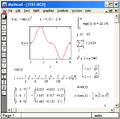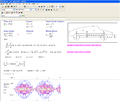Mathcad
 | |
|
Mathcad Prime 1.0 | |
| Developer(s) | Mathsoft, PTC |
|---|---|
| Initial release | 1986 |
| Stable release | |
| Development status | Active |
| Operating system | Microsoft Windows |
| Available in | 10 languages[3] |
| Type | Computer algebra system |
| License | Proprietary |
| Website |
www |
Mathcad is computer software primarily intended for the verification, validation, documentation and re-use of engineering calculations.[4] First introduced in 1986 on DOS, it was the first to introduce live editing of typeset mathematical notation, combined with its automatic computations.
Overview
Mathcad, Parametric Technology Corporation's engineering calculation solution, is used by engineers and scientists in various disciplines – most often those of mechanical, chemical, electrical, and civil engineering. Originally conceived and written by Allen Razdow (of MIT, co-founder of Mathsoft), Mathcad is now owned by PTC and is generally accepted as the first computer application to automatically compute and check consistency of engineering units such as the International System of Units (SI), throughout the entire set of calculations. Mathcad today includes some of the capabilities of a computer algebra system, but remains oriented towards ease of use and simultaneous documentation of numerical engineering applications.
Mathcad is oriented around a worksheet, in which equations and expressions are created and manipulated in the same graphical format in which they are presented (WYSIWYG) - as opposed to authoring in plain text, an approach later adopted by other systems such as Mathematica and Maple.
Mathcad is part of a broader product development system developed by PTC, and often utilized for the many analytical touch points within the systems engineering processes. It integrates with PTC’s other solutions that aid product development, including Creo Elements/Pro, Windchill, and Creo Elements/View. Its live feature-level integration with Creo Elements/Pro enables Mathcad analytical models to be directly used in driving CAD geometry, and its structural awareness within Windchill allows live calculations to be re-used and re-applied toward multiple design models.
Summary of capabilities
The Mathcad interface allows users to combine a variety of different elements (mathematics, descriptive text, and supporting imagery) into the form of a worksheet, which is naturally readable. Because the mathematics are core to the program, the math is inherently live, dynamically recalculating as upstream values are altered. This allows for simple manipulation of input variables, assumptions, and expressions, which in turn update in real-time. The examples below serve to outline the scope of Mathcad’s capabilities, rather than to give specific details on the individual product functionality.
- Utilize numerous numeric functions, across examples such as statistics, data analysis, image processing, and signal processing
- Automatically manage units throughout the worksheet, preventing improper operations and performing automatic unit-reduction
- Solve systems of equations, such as ODEs and PDEs through the use of several methods
- Find roots of polynomials and functions
- Calculate and manipulate expressions symbolically, including within systems of equations
- Create parametric 2D and 3D plot types, as well as discrete data plots
- Leverage standard, readable mathematical expressions within embedded program constructs
- Perform vector and matrix operations, including eigenvalues and eigenvectors
- Perform curve fitting and regression analysis on experimental datasets
- Utilize statistical and Design of Experiments functions and plot types, and evaluate probability distributions
- Import from, and export to, other applications and file types, such as Microsoft Excel and MathML.[5]
- Include references to other Mathcad worksheets to re-use common engineering methods
- Integrate with other engineering applications, such as CAD, FEM, BIM, and Simulation tools, to aid in product design, like Autocad, Ansys, Revit
Although Mathcad is mostly oriented to non-programming users, it is also used in more complex projects to visualize results of mathematical modeling by using distributed computing and coupling with programs written using more traditional languages such as C++.
Current releases
As of early 2015, there are two actively maintained Mathcad releases and a free express version available to consumers:
- Mathcad 15.0 was originally released in June, 2010. Its first maintenance release was released in November, 2010. Mathcad 15.0 is the next progressive release of the traditional product line, sharing the same worksheet file structure and extension as its predecessor, Mathcad 14.0.
- Mathcad Prime 3.0, PTC’s latest generation product, was introduced in October, 2013. According to PTC, this product intends to deliver more functionality with each progressive annual release, until the Mathcad 15.0 maintenance releases can stop in favor of moving forward with a single, scalable, and functionally equivalent application. The Mathcad Prime interface is more graphically interactive, and has adopted Microsoft’s Fluent User Interface as an approach to task-based organization of the different elements of worksheet creation and interaction.
- PTC Mathcad Express Free-for-Life Engineering Calculations Software - a Mathcad Prime 30-day trial, but when the 30-day trial period has ended, it is possible to continue using PTC Mathcad Express for an unlimited time. This Freemium pilot marks a new marketing approach for PTC. Review and markup of engineering notes can now be done directly by team members without them all requiring a full Mathcad Prime license.[6]
Computer operating system platforms
Mathcad is currently a Windows-only application. Current releases of Mathcad 15.0 and Mathcad Prime 1.0 are supported on 32-bit and 64-bit versions of Windows XP, Windows Vista, and Windows 7. Currently releases are 32-bit applications only, however. While users do utilize emulation to establish other platform operability, Mathcad’s last officially supported, natively installed Mac OS release was on January 8, 1998.[7] This version can still be run on Macintosh computers that support the Mac OS X Classic Environment or SheepShaver.
Support
After PTC’s purchase of Mathcad in 2006,[8] changes were made to the Mathcad support policy. That change specified non-maintenance bearing licenses were no longer able to receive updates, including bug fixes, without purchasing a maintenance contract. Though disagreeable to some long-time, pre-PTC-acquisition customers, this is PTC’s standard policy for all its other products.[9] The price of a Mathcad maintenance contract for an individual is roughly half the cost of a single-user license upgrade at the time of a major Mathcad release, and grants the user the right to receive major releases in addition to bug fixes, access to engineering content, technical support, self-service license transferring tools, and more.
The Mathcad Business Unit within PTC recently updated their support policy. For Mathcad 15.0 and future versions of Mathcad, the first year of maintenance entitlements and support will be included in the purchase or upgrade price.
As of September 2014, due to the rapidly changing technology landscape and Microsoft's retiring of the Windows XP operating system, PTC will discontinue PTC Mathcad support of the Windows Vista and XP operating systems with the release of PTC Mathcad Prime 3.1 and PTC Mathcad 15.0 M040.[10]
Release history
| Name | Version | Release Date | Notes |
|---|---|---|---|
| Mathcad 0.3 | 0.3 | beta on 5 1/4 floppy | |
| Mathcad 2.5.2 | 2.5.2 | last DOS version | |
| Mathcad 3.1 | 3.1 | Windows version | |
| Mathcad 4.0 | 4.0 | Windows version | |
| Mathcad 5.0 | 5.0 | ||
| Mathcad 5.5 | 5.5 | Windows version | |
| Mathcad 6.0[11] | 6.0 | ||
| Mathcad 7[12] | |||
| Mathcad 8[13] | |||
| Mathcad 2000[14] | |||
| Mathcad 2001i[15] | |||
| Mathcad 11[16] | |||
| Mathcad 12[17] | |||
| Mathcad 13.0[18] | 13.0 | September 15, 2005[19] | |
| Mathcad 13.1[18] | 13.1 | ||
| Mathcad 14.0[18] | 14.0 | February 12, 2007[19] | |
| Mathcad 15.0[20] | 15.0 F000 | June 25, 2010[19] | |
| Mathcad 15.0 M010[20] | 15.0 M010 | June 29, 2011[19] | |
| Mathcad 15.0 M040[19] | 15.0 M040 | ||
| Mathcad 15.0 M045[21] | 15.0 M045 | November 2015[21] | |
| Mathcad Prime 1.0[22] | January 10, 2011[19] | ||
| Mathcad Prime 2.0 | February 29, 2012[19] | ||
| Mathcad Prime 3.0 | October 2, 2013[19] | ||
| Mathcad Prime 3.1 | March 2, 2015[19] |
Screen captures of previous Mathcad versions
 Mathcad 2.52 (1989)
Mathcad 2.52 (1989) Mathcad 3.1 (1992)
Mathcad 3.1 (1992) Mathcad PLUS 6.0 (1995)
Mathcad PLUS 6.0 (1995) Mathcad 13.0
Mathcad 13.0 Mathcad 15.0
Mathcad 15.0 Mathcad Prime 1.0
Mathcad Prime 1.0 Mathcad Prime 1.0 working session
Mathcad Prime 1.0 working session
See also
- Comparison of computer algebra systems
- Comparison of numerical analysis software
- TK Solver
- PTC:Creo
- PTC:Windchill
- SMath Studio, a free software similar to MathCad
References
- ↑ "READ THIS FIRST PTC® Mathcad® 15.0 M045" (PDF). November 2015.
- ↑ "PTC Introduces PTC Mathcad Prime 3.1". 2015-03-02.
- ↑ "Mathcad Language Support - PTC.com".
- ↑ "PTC Mathcad - PTC".
- ↑ http://www.jmcsweeney.co.uk/webdesign/mathcad.php
- ↑ ENGINEERING.com. "Psst... PTC is Giving Away Mathcad Express. Pass it on. > ENGINEERING.com".
- ↑ http://www.versiontracker.com/dyn/moreinfo/macos/2770
- ↑ PTC to Acquire Mathsoft Engineering & Education (April 26, 2006 slide show),
- ↑ "Global Maintenance Support - Packages - PTC.com".
- ↑ "PTC Mathcad Support Announcement". http://blogs.ptc.com/2014/09/25/ptc-mathcad-operating-systems-support-announcement/. External link in
|website=(help); - ↑ "Mathcad Features Comparison Chart". Archived from the original on 1996-11-10. Retrieved 2016-06-12.
- ↑ "Mathcad PLUS 6.0 and Mathcad 7 Professional Comparison". Archived from the original on 1998-02-20. Retrieved 2016-06-12.
- ↑ "Mathcad Features: Version by Version Comparison". Archived from the original on 2000-09-29. Retrieved 2016-06-12.
- ↑ "Mathcad Version Comparison Chart". Archived from the original on 1999-11-28. Retrieved 2016-06-12.
- ↑ "What's New in Mathcad 2001i". Archived from the original on 2001-02-15. Retrieved 2016-06-11.
- ↑ "What's New in Mathcad 11". Archived from the original on 2002-11-11. Retrieved 2016-06-11.
- ↑ "Untitled" (PDF). Archived from the original (PDF) on 2004-09-16. Retrieved 2016-06-12.
- 1 2 3 "Release Notes for Mathcad 14". Retrieved 2016-06-12.
- 1 2 3 4 5 6 7 8 9 "When to release Mathcad 15 M040?". Retrieved 2016-06-12.
- 1 2 "Latest Release of MC15 (M0??)". Retrieved 2016-06-12.
- 1 2 "Mathcad 15 M045 release notes ("Read This First" guide)". Retrieved 2016-06-12.
- ↑ "Choose the Mathcad® product that's right for you" (PDF). Archived from the original (PDF) on 2011-08-10. Retrieved 2016-06-12.